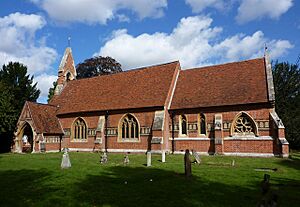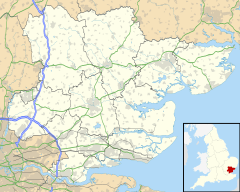Twinstead facts for kids
Quick facts for kids Twinstead |
|
|---|---|
 Church of St John the Evangelist, Twinstead |
|
| Population | 165 (2001 census) |
| OS grid reference | TL8588236642 |
| Civil parish |
|
| District |
|
| Shire county | |
| Region | |
| Country | England |
| Sovereign state | United Kingdom |
| Post town | Sudbury |
| Postcode district | CO10 |
| Dialling code | 01787 |
| Police | Essex |
| Fire | Essex |
| Ambulance | East of England |
| EU Parliament | East of England |
| UK Parliament |
|
| Website | http://www.essexinfo.net/the-hennys-middleton-and-twinstead-parish-council/ |
Twinstead is a small village in Essex, England. It's part of the Braintree area. Twinstead shares a local council with two other villages, Great Henny and Little Henny. This council is called "Hennys', Middleton & Twinstead". In 2001, about 165 people lived in Twinstead.
Long ago, in the 1870s, Twinstead was described as having 1,008 acres of land. There were 48 houses in the village. Today, Twinstead has many farms and even a riding school. You can also find a large manor house and a business that deals with Volvo cars. The village has one church, the Church of St John the Evangelist. This church is a very important historic building, known as a Grade II* listed building.
Contents
The Church of St John the Evangelist
The church you see today is actually the fourth one built on this spot! The first church was ruined in 1790. The second one was taken down, and the third was not considered suitable. So, a new church was needed.
This fourth church was built between 1859 and 1860. It was designed by Henry Woodyer. The outside of the church is made of red bricks with stone details. But the inside is much more colorful and fancy. You'll see black and red bricks along the walls. There's also an orange-brown pattern above them. The church's Victorian design makes it stand out.
The oldest part of the church is its bell. This bell dates all the way back to the early 1500s! It was rehung in 1976. What makes Twinstead Church even more special is its unique entrance to the chancel (the area around the altar). It has three equal stone arches. It's thought to be one of only three churches in England with this feature. It's definitely the only one like it in a countryside setting.
Twinstead's History
What's in a Name?
The name Twinstead has a long history. It was first written down in the Domesday Book as "Tumesteda". Since the 1100s, it has been called different names like Tumstead or Tunstead. The word "Twinn" comes from Old English and means "double". "Stede" means "place". So, Twinstead likely means "double homestead" or "two places".
The Manor House's Story
The Manor House in Twinstead has been around for a very long time. In 1086, a person named Richard Fitz-Gilbert owned it. Over the centuries, it changed hands many times. By 1374, it belonged to Simon Sudbury, who was an important church leader.
The house used to be surrounded by a deep moat (a ditch filled with water). A light bridge connected the house to the gardens. The moat is gone now, but the old bridge is still there. While many parts of the house have been updated, some ancient features remain. Today, the Manor House is a hotel.
Twinstead's Location and Weather
| Weather chart for | |||||||||||||||||||||||||||||||||||||||||||||||
|---|---|---|---|---|---|---|---|---|---|---|---|---|---|---|---|---|---|---|---|---|---|---|---|---|---|---|---|---|---|---|---|---|---|---|---|---|---|---|---|---|---|---|---|---|---|---|---|
| J | F | M | A | M | J | J | A | S | O | N | D | ||||||||||||||||||||||||||||||||||||
|
105
7
3
|
39
7
2
|
80
9
3
|
71
12
4
|
50
18
10
|
123
20
13
|
45
22
15
|
51
22
15
|
46
21
14
|
28
14
9
|
82
9
4
|
21
9
4
|
||||||||||||||||||||||||||||||||||||
| temperatures in °C precipitation totals in mm source: [1] |
|||||||||||||||||||||||||||||||||||||||||||||||
|
Imperial conversion
|
|||||||||||||||||||||||||||||||||||||||||||||||
Twinstead is located about 49 miles northeast of London. It's also close to the town of Sudbury, which is about 3 miles south. The village sits on land that is about 81 meters (226 feet) high.
The A131 road is the main road that goes through Twinstead. If you want to travel by train, the closest stations are Bures and Sudbury.
Twinstead has a maritime climate. This means its weather is influenced by the sea. Temperatures usually range from a low of 2°C in winter to a high of 22°C in summer. In the past, the area had good soil for growing crops. This helped farming to be successful.
Population Changes
Before the 1800s, the Domesday Book recorded that Twinstead had 25 households. This was quite a large number compared to other nearby settlements. For example, Pebmarsh also had 25 households, and Lamarsh had 31. Twinstead also paid very little tax back then.
How Twinstead's Population Changed Over Time
The number of people living in Twinstead has changed a lot over the years. In 1801, when the first census was taken, there were 181 people. By 1811, this number dropped to 139. But then it went up again to 202 people in 1821. The population stayed fairly steady until 1901, when it dipped to 145 people.
After that, the population went up and down. In the 2011 Census, the population of the civil parish (which includes Pebmarsh) was 155. In 2011, there were 79 males and 76 females. This is different from 1801, when there were 96 males and 85 females. Not only has the total population gone down, but the number of males and females is now much closer.
Who Lives in Twinstead?
Historically, Twinstead has mostly been home to people of White-British origin. This is partly because the church had a big influence in the past. Even today, Twinstead is less diverse than the average for the UK.
In the 2001 Census, 157 people were recorded as White-British. Four people were of mixed White and Black African origin. By the 2011 Census, 150 people were White-British. Four people were of other white origins, and one person was of Arab origin. So, while there have been small changes, Twinstead remains a mostly White area.
Jobs and Community
In the early 1800s, people were grouped into three main job types: employers and professionals, the "middling sorts" (like skilled workers), and laborers and servants.
By the late 1800s, jobs became more varied. A chart from 1881 shows that many men worked in agriculture, especially as farm laborers. Women often worked in domestic services, like housekeepers. This shows that more different types of jobs were becoming available.
By 2011, the kinds of jobs in Twinstead had changed a lot, just like in many other parts of the UK. Many jobs in farming were gone. Instead, people worked as managers, directors, or in professional and technical roles. There were also people in administrative jobs, skilled trades, caring services, sales, and other types of work.
Sports and Fun
The two main sports in Twinstead are riding and cricket. Twinstead Riding School has been teaching people to ride since 1956. They have 40 horses and 135 acres of land. This means they can teach riders of all ages and skill levels.
Twinstead Cricket Club, also known as Twinstead CC, is for people who love cricket. They have many social events throughout the year, keeping the community active and connected.





